Abstract
OBJECTIVES: To determine the extent of contamination of ovarian follicular fluid and serum samples in women undergoing in-vitro fertilization and to study the effect of the contaminants on reproductive outcome. DESIGN: Inception cohort study. PATIENTS: Seventy-four women undergoing in-vitro fertilization at three regional clinics in Halifax, Hamilton, Ont., and Vancouver. MAIN OUTCOME MEASURES: Follicular fluid and serum levels of contaminants, cleavage rates and time to cleavage of first egg. RESULTS: Five chlorinated organic chemicals were frequently found in the two types of samples: alpha-chlordane (ALCH), dichlorochlorophenylethylene (DDE), heptachloroepoxide-oxychlordane (OXCH), hexachlorobenzene (HCB) and polychlorinated biphenyl (PCB). The levels were generally low. Regional differences between the three clinics were present. Samples from the Halifax clinic had the lowest frequency and level of contamination. The source of drinking water (well, bottled or municipal) was an important confounder. The concentrations of the five contaminants did not affect the cleavage rate or the time to cleavage of the first egg. CONCLUSION: Trace amounts of toxic and persistent chlorinated organic chemicals found in the follicular fluid of Canadian women undergoing in-vitro fertilization did not seem to have any adverse biologic effect on the rate of fertilization and the time to cleavage. Reasons for regional differences in the concentrations of contaminants require further study.
Full text
PDF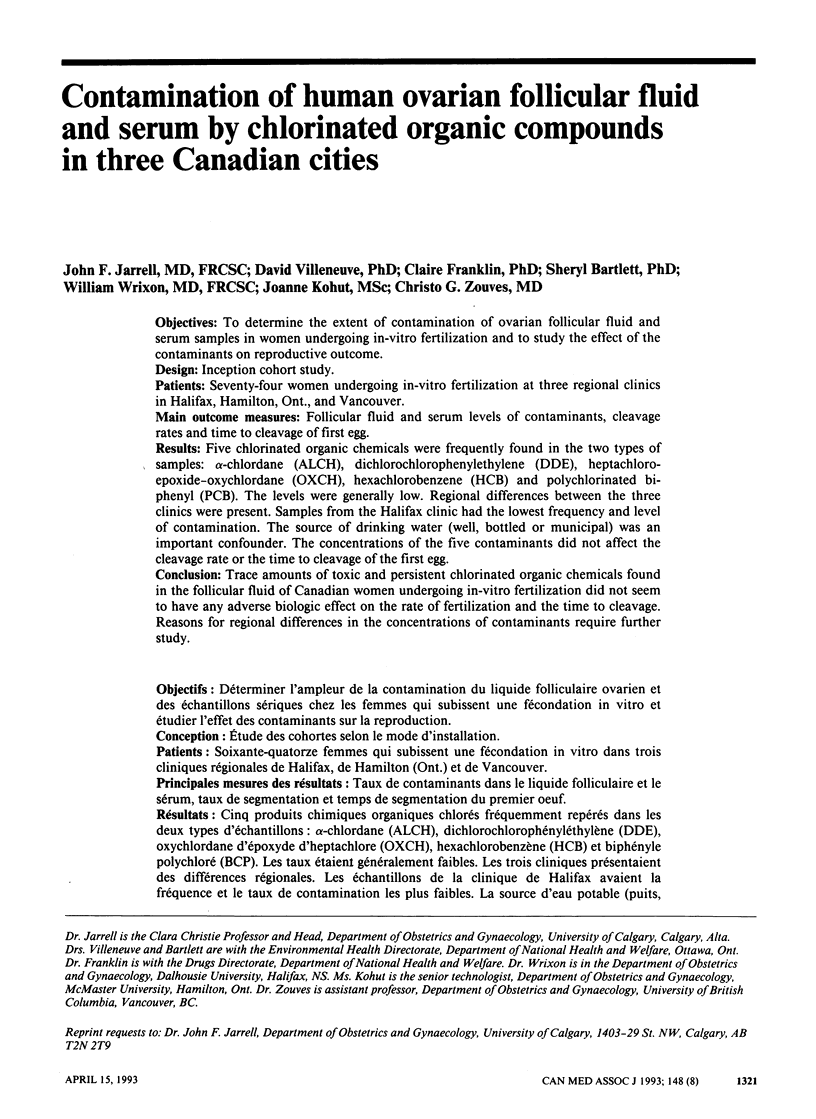
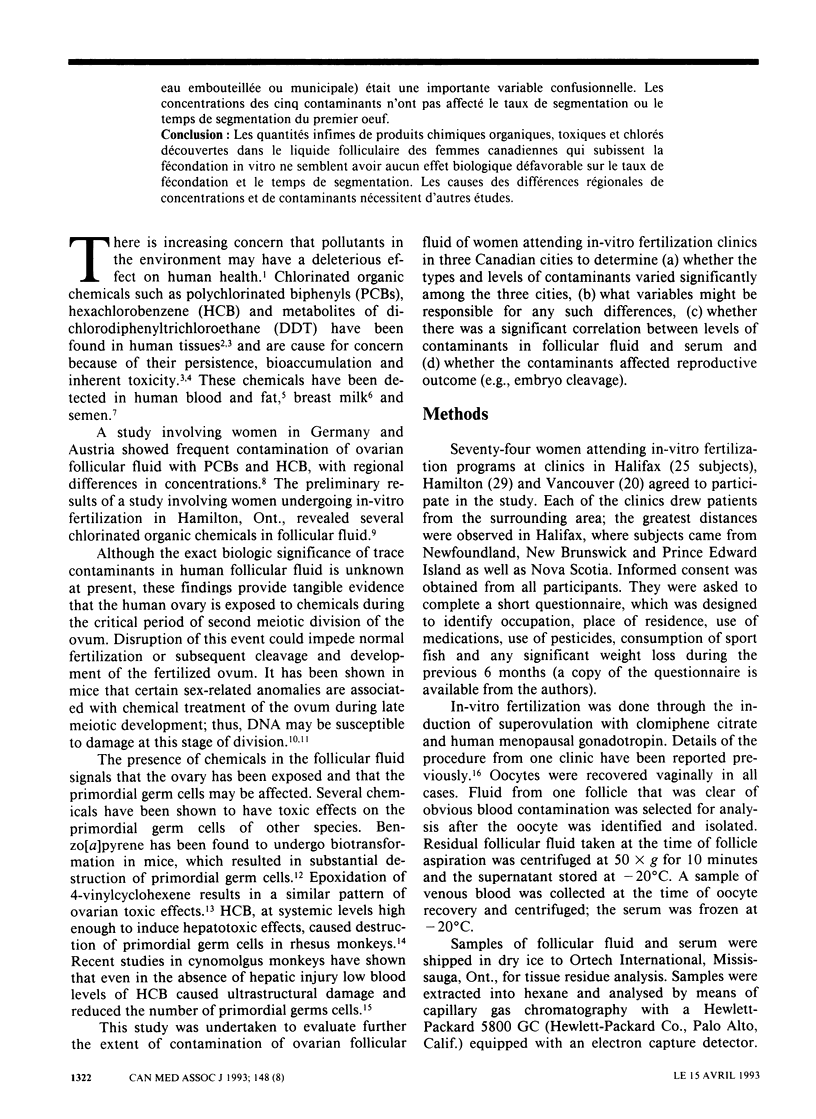
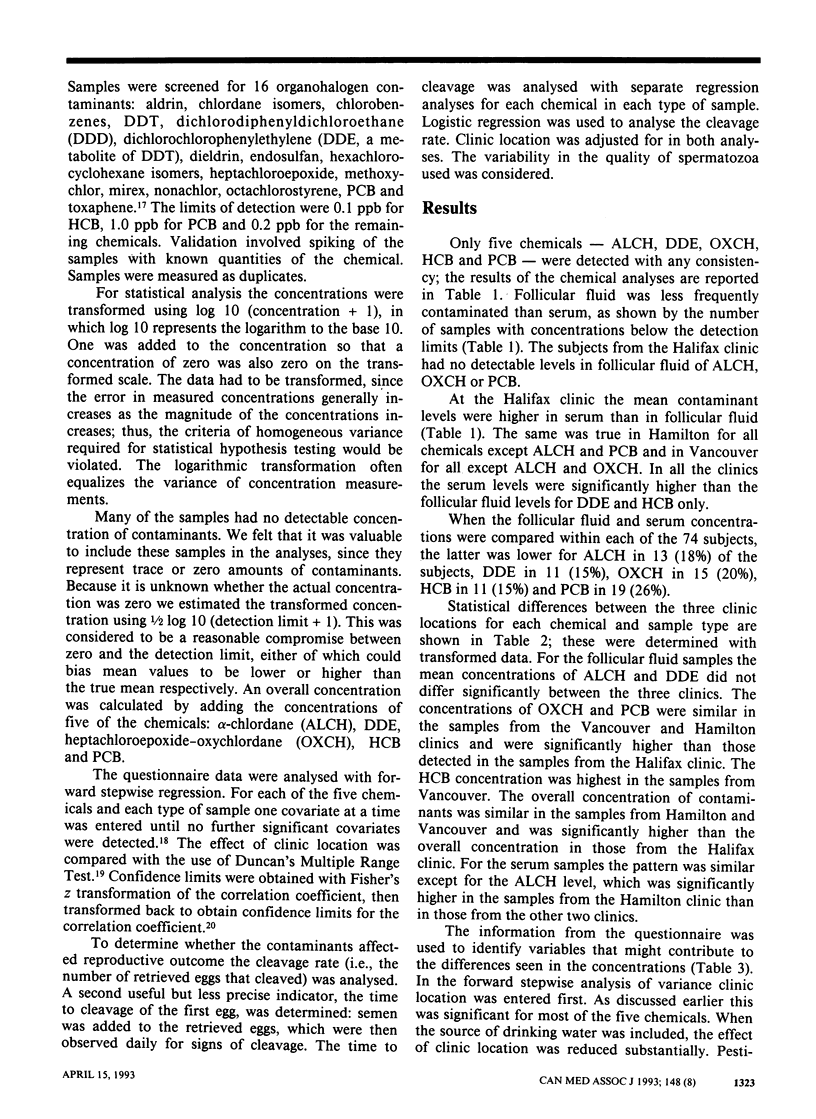
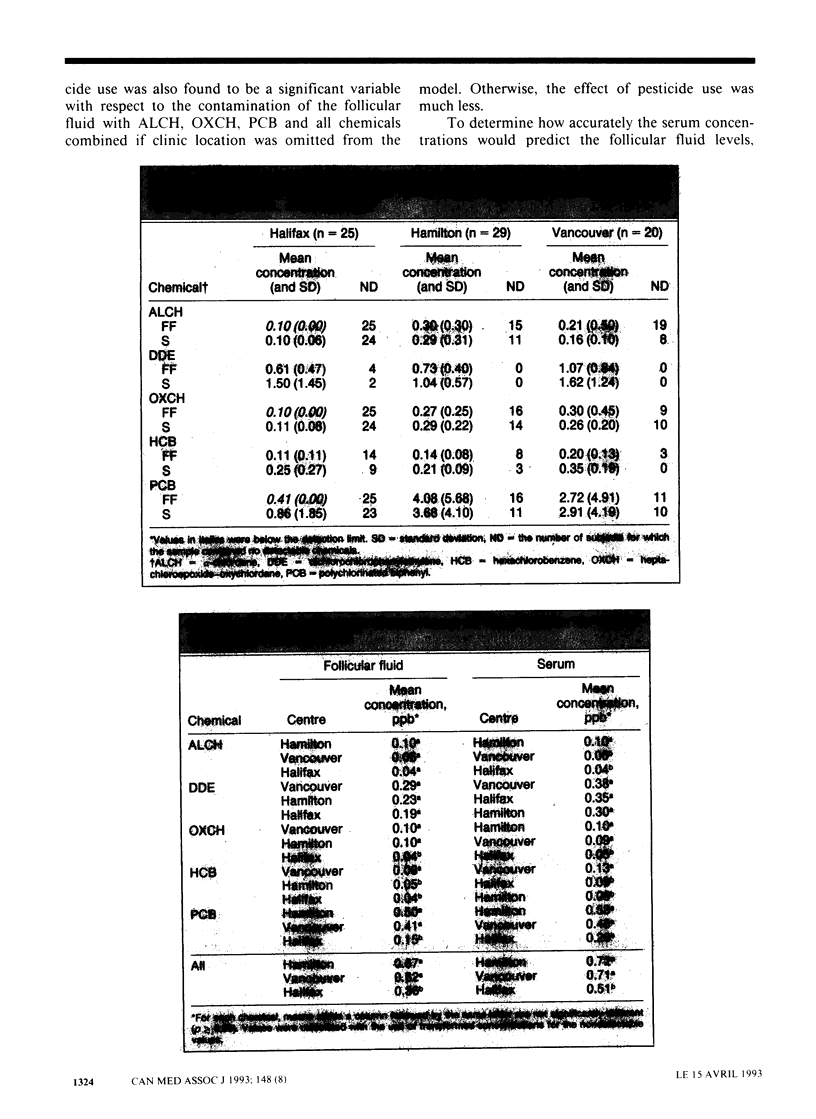


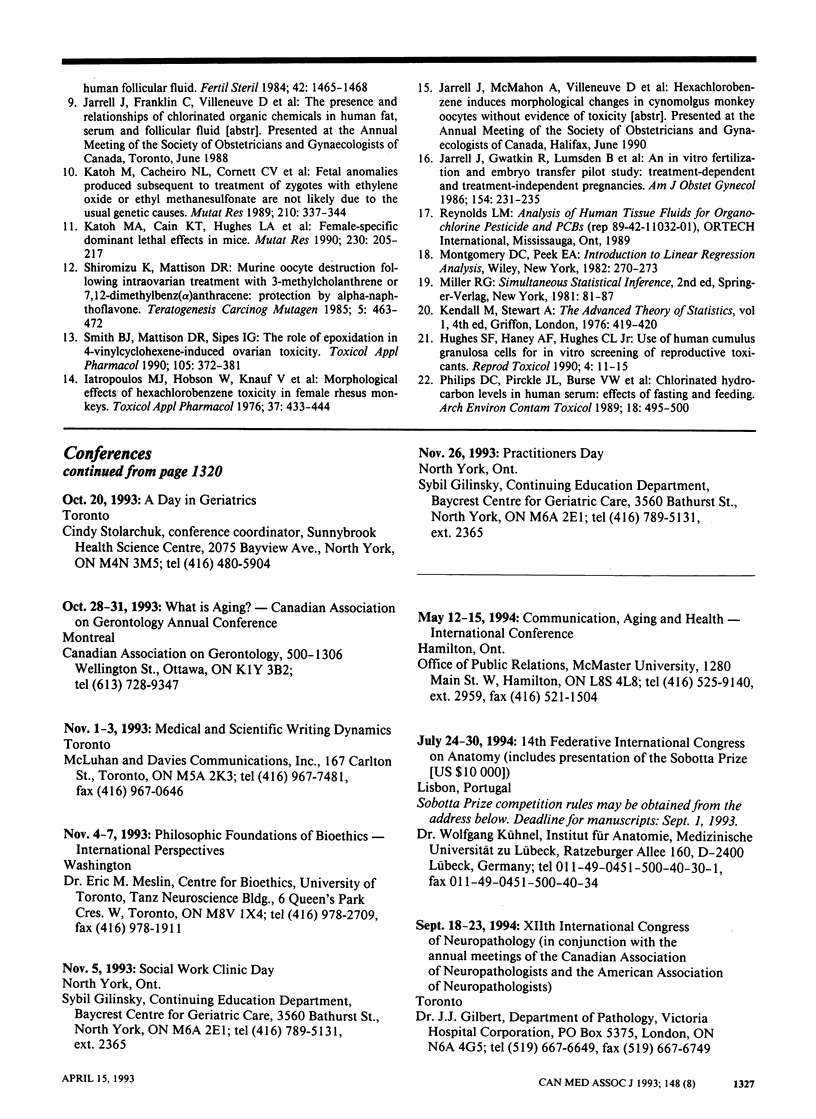
Selected References
These references are in PubMed. This may not be the complete list of references from this article.
- Carey A. E., Dixon T. E., Yang H. S. Environmental exposure to hexachlorobenzene in the USA. IARC Sci Publ. 1986;(77):115–120. [PubMed] [Google Scholar]
- Hughes S. F., Haney A. F., Hughes C. L., Jr Use of human cumulus granulosa cells for in vitro screening of reproductive toxicants. Reprod Toxicol. 1990;4(1):11–15. doi: 10.1016/0890-6238(90)90073-5. [DOI] [PubMed] [Google Scholar]
- Iatropoulos M. J., Hobson W., Knauf V., Adams H. P. Morphological effects of hexachlorobenzene toxicity in female rhesus monkeys. Toxicol Appl Pharmacol. 1976 Sep;37(3):433–444. doi: 10.1016/0041-008x(76)90205-2. [DOI] [PubMed] [Google Scholar]
- Jarrell J., Gwatkin R., Lumsden B., Lamont K. G., Boulter G., Daya S., Collins J. An in vitro fertilization and embryo transfer pilot study: treatment-dependent and treatment-independent pregnancies. Am J Obstet Gynecol. 1986 Feb;154(2):231–235. doi: 10.1016/0002-9378(86)90645-9. [DOI] [PubMed] [Google Scholar]
- Jones G. R. Polychlorinated biphenyls: where do we stand now? Lancet. 1989 Sep 30;2(8666):791–794. doi: 10.1016/s0140-6736(89)90844-1. [DOI] [PubMed] [Google Scholar]
- Katoh M. A., Cain K. T., Hughes L. A., Foxworth L. B., Bishop J. B., Generoso W. M. Female-specific dominant lethal effects in mice. Mutat Res. 1990 Jun;230(2):205–217. doi: 10.1016/0027-5107(90)90058-c. [DOI] [PubMed] [Google Scholar]
- Katoh M., Cacheiro N. L., Cornett C. V., Cain K. T., Rutledge J. C., Generoso W. M. Fetal anomalies produced subsequent to treatment of zygotes with ethylene oxide or ethyl methanesulfonate are not likely due to the usual genetic causes. Mutat Res. 1989 Feb;210(2):337–344. doi: 10.1016/0027-5107(89)90095-x. [DOI] [PubMed] [Google Scholar]
- Leoni V., Fabiani L., Marinelli G., Puccetti G., Tarsitani G. F., De Carolis A., Vescia N., Morini A., Aleandri V., Pozzi V. PCB and other organochlorine compounds in blood of women with or without miscarriage: a hypothesis of correlation. Ecotoxicol Environ Saf. 1989 Feb;17(1):1–11. doi: 10.1016/0147-6513(89)90002-x. [DOI] [PubMed] [Google Scholar]
- Phillips D. L., Pirkle J. L., Burse V. W., Bernert J. T., Jr, Henderson L. O., Needham L. L. Chlorinated hydrocarbon levels in human serum: effects of fasting and feeding. Arch Environ Contam Toxicol. 1989 Jul-Aug;18(4):495–500. doi: 10.1007/BF01055015. [DOI] [PubMed] [Google Scholar]
- Risebrough R. W., Rieche P., Peakall D. B., Herman S. G., Kirven M. N. Polychlorinated biphenyls in the global ecosystem. Nature. 1968 Dec 14;220(5172):1098–1102. doi: 10.1038/2201098a0. [DOI] [PubMed] [Google Scholar]
- Shiromizu K., Mattison D. R. Murine oocyte destruction following intraovarian treatment with 3-methylcholanthrene or 7,12-dimethylbenz(a)anthracene: protection by alpha-naphthoflavone. Teratog Carcinog Mutagen. 1985;5(6):463–472. doi: 10.1002/tcm.1770050609. [DOI] [PubMed] [Google Scholar]
- Smith B. J., Mattison D. R., Sipes I. G. The role of epoxidation in 4-vinylcyclohexene-induced ovarian toxicity. Toxicol Appl Pharmacol. 1990 Sep 15;105(3):372–381. doi: 10.1016/0041-008x(90)90141-g. [DOI] [PubMed] [Google Scholar]
- Stachel B., Dougherty R. C., Lahl U., Schlösser M., Zeschmar B. Toxic environmental chemicals in human semen: analytical method and case studies. Andrologia. 1989 May-Jun;21(3):282–291. [PubMed] [Google Scholar]


